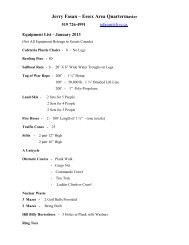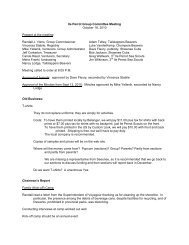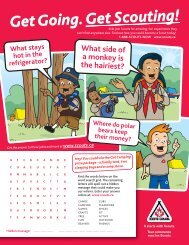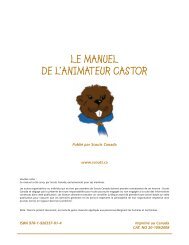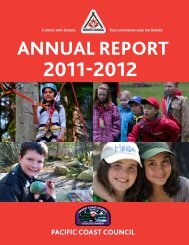Beaver Leader's Handbook - Scouts Canada
Beaver Leader's Handbook - Scouts Canada
Beaver Leader's Handbook - Scouts Canada
You also want an ePaper? Increase the reach of your titles
YUMPU automatically turns print PDFs into web optimized ePapers that Google loves.
6-4<br />
Active listening skills are essential to good communication. Listen with full attention and respond<br />
to the feelings that lie behind the words. It’s easy to tell if someone is really listening, because<br />
we can see it in a person’s body posture. When children are talking to you, face them and try to<br />
position yourself at their level to increase the intimacy of the communication.<br />
If you acknowledge the feelings you hear coming through, and couple<br />
your recognition with a caring attitude, you help children explore<br />
their own thoughts and feelings. In this way, you<br />
help them work towards developing<br />
their own solutions to problems.<br />
It can’t happen if you simply ask<br />
questions and give advice.<br />
When children are upset, it’s important<br />
not to deny their feelings<br />
and simply try to get them back on<br />
track. Instead, try to give what they<br />
are feeling a name (e.g. “It seems<br />
that you are feeling hurt.”). This approach<br />
helps children understand their emotions.<br />
Beware of long-winded explanations. If<br />
children are behaving badly, express<br />
your feelings, tell them in simple words what behaviour you expect from them and, if necessary,<br />
help them get started in a positive way.<br />
Hawkeye’s Tip:<br />
Be aware and creative when communicating with <strong>Beaver</strong>s. <strong>Beaver</strong>s can’t understand complicated<br />
messages or large unfamiliar words. They have relatively short attention spans; you will<br />
notice their attention start to wander. When you approach communicating with <strong>Beaver</strong>s, use<br />
a different tone and volume to convey a message and grab their attention. Don’t just talk to<br />
them, allow them to experience something through their senses (e.g. taste, touch, smell). If you<br />
have a visitor, ask them to get down to the <strong>Beaver</strong>’s level and talk to them one on one. <strong>Beaver</strong>s<br />
sometimes have difficulty asking questions; it doesn’t hurt to paraphrase their question to<br />
make sure you understand.<br />
Here are some key words <strong>Beaver</strong>s might use when trying to express their true feelings. Add your<br />
own to the list.<br />
Happy, Friendly, Peaceful: cheerful, brotherly, glad, good, gentle, laughing, wonderful,<br />
nice, warmhearted.<br />
Playful, Confident, Interested: brave, clever, excited, funny, smart, lively, thinking,<br />
interested, wondering.<br />
Angry, Hostile, Frustrated: angry, boiling, cranky, cross, fierce, fighting, mad, mean,<br />
out-of-sorts, pushy, ready to explode.<br />
Afraid, Guilty, Worried: put down, silly, sorry, wrong, afraid, frightened, trembling,<br />
worried, nervous, troubled.<br />
Lonely, Miserable: alone, forgotten, lost, hurt, lousy, miserable, rotten, sore,<br />
troubled, unlucky.



